Methyl aminolevulinate Photodynamic therapy
What is methyl aminolevulinate?
Methyl aminolevulinate (MAL) is a topical photosensitising agent that is used in photodynamic therapy (PDT). It is available as a 16% strength cream in a 2g tube. The trade name is Metvix™.
How does methyl aminolevulinate PDT work?
When applied to the skin, methyl aminolevulinate is selectively absorbed into cancer cells. The drug is converted into photoactive porphyrins, naturally-occurring intracellular photosensitising chemicals that bind with iron to make haemoglobin. When cancer cells full of porphyrins are exposed to specific wavelength of light (570–670 nm), a molecular reaction occurs that results in destruction of the cancer cells.
What is methyl aminolevulinate PDT used for?
Methyl aminolevulinate is classed as an antineoplastic agent (anti-cancer drug) and is approved for use in Australia for the treatment of:
- Thin actinic keratoses on the face and scalp
- Superficial and/or thin nodular basal cell carcinomas.
MAL-PDT is recommended for lesions that are unsuitable for other available therapies due to possible complications and/or poor cosmetic outcome. It may be particularly useful for lesions on the mid-face or ears, lesions on severely sun damaged skin, large lesions or recurrent lesions.
Clinical trials around the world using MAL-PDT have shown it to have comparable cure rates to other conventional treatments such as cryotherapy or surgery. A distinct advantage of MAL-PDT is that it selectively targets tumour cells. This means that surrounding healthy cells are not affected by the treatment thus leaving minimal scarring and a much better cosmetic outcome.
How is MAL-PDT given?
MAl-PDT involves a two-stage process. The first stage is application of the methyl aminolevulinate cream.
PDT for actinic keratoses
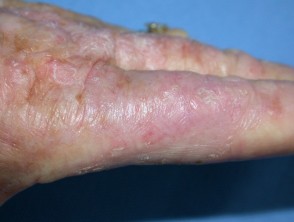
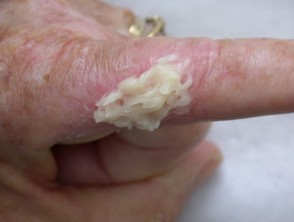
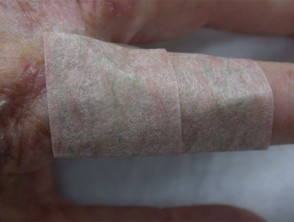
- The surface of the skin lesion is prepared by removing scales and crusts (light scraping, curretage or superficial microneedling). The top of the lesion may need to be removed so that it is less than 1 mm in thickness.
- A spatula is used to apply a 1-mm thick layer of methyl aminolevulinate cream to the lesion and surrounding 5 mm of normal skin.
- The treated area is covered with an occlusive dressing for 3 hours. During this time the dressing should be left undisturbed and the area kept out of direct sunlight.
Metvix PDT
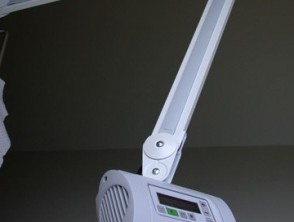
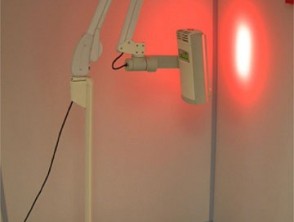
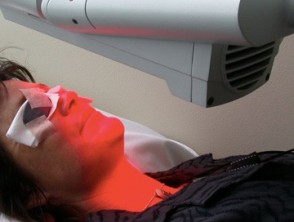
The second stage involves exposing the lesion to light.
- The dressing is removed and the treatment area is cleaned with saline to remove the methyl aminolevulinate cream.
- Lignocaine (lidocaine) spray or cooling fan may be applied to relieve burning sensation and pain that may occur. Pain killers may be necessary.
- The lesion is exposed to red light with a continuous spectrum of 570–670 nm and a total dose of 75 J/cm2. A source of red light with a narrower spectrum may be used, for example Aktilite™ (illustrated, wavelength 630 nm, 70–100 mW/cm2). Both doctor and patient should wear protective eye goggles and the light source should be 50 mm from the skin lesion. Treatment may take 5–15 minutes.
- Light intensity at the lesion surface should not exceed 200 mW/cm2.
After treatment the lesions will be covered with an occlusive dressing for at least 24 hours. Lesions usually heal completely within one to four weeks. More than one lesion can be treated in a single treatment session. A repeat second treatment may be done approximately one week later: this is recommended for most basal cell carcinomas and thicker actinic keratoses.
The practitioner should check the lesions after about 3 months. If they show a non-complete response, re-treatment may be necessary.
Basal cell carcinoma treated with PDT
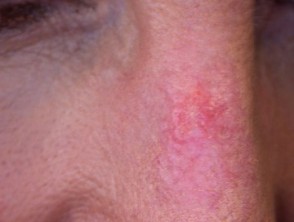
Prior to treatment
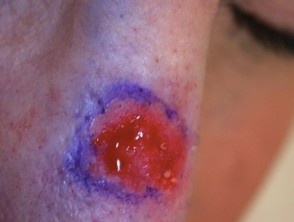
Lesion scraped
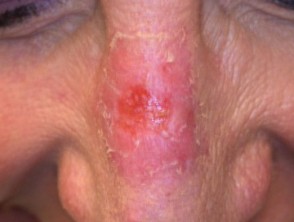
One week after MAL PDT
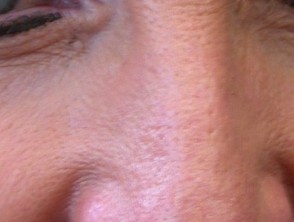
One month after MAL PDT
Precautions during MAL-PDT
- The safety of MAL-PDT has not yet been established in patients under 18 years old, but skin cancers very rarely affect this age group.
- The safety of MAL-PDT has not yet been established in pregnancy or breastfeeding. It is therefore not recommended for use during pregnancy.
- Discontinue breastfeeding for 48 hours after application of methyl aminolevulinate.
- Hypersensitivity or allergic reactions to active substance or any of the excipients may occur. These include:
- Arachis (peanut) oil
- Cetostearyl alcohol
- Methyl- and propyl-para hydroxybenzoate (E218, E216).
- Avoid sun exposure on treated lesions sites for at least a couple of days following treatment.
Pain management
Pain threshold varies between individuals. It is mediated by induction of free radicals by protoporphyin IX.
- Pain tends to greater when PDT is undertaken in certain sites (face and scalp) and in larger lesions.
- PDT is more painful with high fluence lamps (especially when fluence is > 50 mW cm−2).
- If MAL-PDT treatment is very painful, exposure to the light can be temporarily stopped. When ready to recommence, the light source can be moved further away from the treatment area, and exposure recommenced. The exposure time will need to be adjusted. Slower treatments are usually less painful.
- Cold air by means of a cooling fan may provide relief.
Topical anaesthesia is not effective. Local (dermal) infiltration of anaesthetic should be avoided due to theoretical reduction if efficacy of treatment due to reduced oxygenation of tissue. Subcutaneous anaesthesia and nerve blocks in expert hands may be beneficial.
Side effects of MAL-PDT
Approximate 60–80% of patients undergoing MAL-PDT experience some side effects. These are usually related to the treated area being sensitive to light and are like sunburn. Side effects are of mild to moderate intensity and usually subside within a few days after treatment.
As the skin cancers cells die off, the lesion may blister and ulcerate. This generally heals within 4 weeks.
Frequency of reported side effects
Very common
- Burning sensation
- Stinging sensation
- Pain
- Swelling
- Crusting
- Redness
Common
- Itchiness
- Ulceration
- Suppuration
- Blisters
- Peeling
- Skin infection
- Hyper/hypopigmentation
Uncommon
- Urticaria
Storage and handling of methylaminolevulinate cream
- Store in a refrigerator (below 8C).
- Discard 1 week after opening the tube.
MAL-PDT using natural daylight
Daylight-mediated PDT is a convenient form of treatment of thin actinic keratoses on the face and scalp. Results have been shown to be as good as with conventional MAL-PDT (described above). Treatment can be undertaken during spring, summer or autumn in most parts of the world.
The natural daylight PDT procedure is as follows:
- To improve efficacy, patients can be using a peeling agent for 10 days or so prior to treatment (eg urea cream)
- A suitable day is selected for treatment; overcast with temperature over 10C is best. In most parts of the world, treatment can be undertaken year-round during office hours. Rainy days are unsuitable.
- The skin to be treated is gently washed.
- A clear sunscreen is applied to all skin to be exposed to daylight including intended treatment area (it can also be applied after the treatment cream)
- The field to be treated is marked out
- Scale and crust are lightly scraped off
- Methyl aminolevulinate cream is applied to the field. One to two grams (one tube) will treat the entire face.
- No more than half an hour later, the patient should go outdoors to expose the treated area to daylight. Delay in exposure leads to greater pain.
- If it is sunny during summer, stay in a lightly shaded area. If it starts to rain, move to an outdoor shelter exposed on 3 sides.
- Sit quietly during the session, rather than taking exercise, as sweat will reduce penetration of the medication.
- Two hours later, the cream is washed off using saline.
- Remain indoors for the rest of the day. If it is essential to be outdoors, reapply broad-spectrum sunscreen and/or cover up.
Natural daylight PDT is followed by sunburn-like inflammation in treated areas for 5 to 8 days. The skin is red, and may become blistered and crusted. The reaction tends to be most severe at 3 to 4 days after treatment. Redness can be reduced by pre-treatment with topical steroid.
Similar cure rates as conventional MAL-PDT and excellent cosmetic results are described for thin actinic keratoses. Advantages of natural daylight PDT include:
- The procedure is less painful
- Large areas of sun damage can be treated on a single occasion
- The procedure may prove less expensive.
Daylight MAL-PDT may also be undertaken indoors. Lux should be > 5,000 for it to be effective in the treatment of actinic keratoses. Options include:
- Placing the patient within a a greenhouse, where sunscreen is unnecessary
- Using an artificial source of white light, such as operating lamp, projector or LED lamps.

